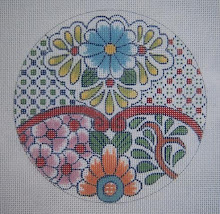 The egg is moving along, but slowly, as I've had too many other things going on this week.
The egg is moving along, but slowly, as I've had too many other things going on this week.For the white on this plaid, I've used the DMC floss #3865, which is not the bright white, the "Blanc" we're more used to, but just barely "off white." Very nice! The Smyrna Cross frame around the oval is the blanc pearl cotton, as I wanted it to stand out and make a statement.
While working on the egg a few days ago, I remembered another piece I was doing several years ago, in which I was bored and tired of the project, so decided to see what would happen if I worked the weft horizontals in the plaid with beads instead of thread - the results were amazing, and put me on a whole new path in my work with beads and needlepoint!
See that post on the other blog, (Possibilities, Etc.) If this hadn't been about creating plaid and using it for something specific, I would have used beads on this egg. I was so enchanted with this "beaded solid" look, that I used it for yet another plaid - this time one I saw as an upholstery fabric in a magazine. It's actually one with stripes of equal width, but separated by very narrow stripes of gold - perfect for an evening bag.
 This picture is a photo of a scan of the original sample, (I lost it long ago) so does't really show how striking it is with the beads. - but you can get the idea. Also, this demonstrates another small variation one can do to develop a plaid.
This picture is a photo of a scan of the original sample, (I lost it long ago) so does't really show how striking it is with the beads. - but you can get the idea. Also, this demonstrates another small variation one can do to develop a plaid.



















